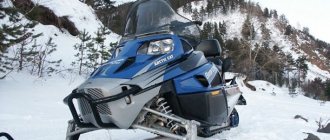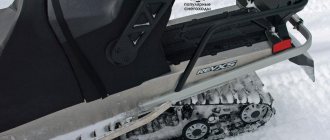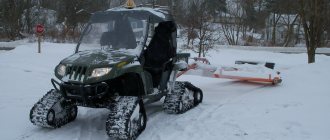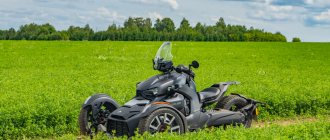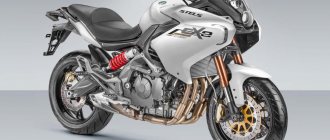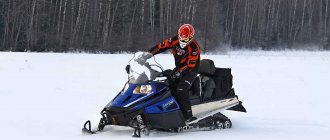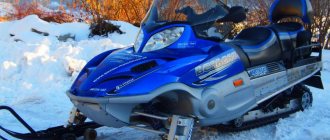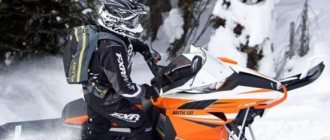Arctic Cat developed and brought to life the M 8000 HCR 153 snowmobile (the modern analogue is the Arctic Cat M8000 153 HCMC), its main purpose is driving in deep snow. Because of its capabilities, it has taken pride of place in the top of all snowmobiles.
This result was achieved thanks to the Suzuki engine. Its volume is 800 cubic meters, fuel injection is regulated by an electronic injector. Despite the small size of the engine, the engineers managed to squeeze 163 horsepower out of it. Such good performance was achieved thanks to the installation of a lightweight crankshaft and electronic exhaust valves, which are equipped with temperature sensors.
The M 8000 HCR 153 has a unique drive system. It includes a cross-shaped crankshaft, good hydraulic brakes and a strong drive chain. Snowmobile brakes are lightweight and feature a radial master cylinder and very lightweight discs.
As for the front suspension, the M 8000 was equipped with Float EVOL shock absorbers, custom-made by FOX. Its stroke is 23 centimeters. The snowmobile was also equipped with ProCross skis. It is worth noting that they are not very suitable for eating in deep snow.
The model featured a unique rear suspension with 40 cm of rear travel. It was designed by Arctic Cat and FOX.
On this model, the engineers decided to use a fixed steering wheel with a vertical post, rather than installing the usual telescopic steering type.
The driver's seat was made very comfortable. It is also worth noting the housing heating system, which will protect it from ice freezing. If we compare the model of this year and 2012, we can safely say that the first model has significantly less snow and ice on the hull than before. Moreover, the weight of the system is 2 kg less.
The dashboard allows you to fully control your ride. Operating modes: digital and analog. On the panel, in addition to standard indicators, you can monitor altimeter data and trip duration.
For good traction on the road, a 3.9-meter PowerClaw track was used; to put it simply, it’s a caterpillar. To quickly move through the snow, ridges with a height of 660 mm are installed on the track in increments of 750 mm. The hardness of the track is 85. Thanks to the forward curved tread, the snow will first be compacted and only after that the ridges will begin their work.
This snowmobile is more suitable for professionals who have seen a lot in their lifetime. This is due to the fact that the M 8000 is not controllable enough, and it will be difficult for a beginner to handle it.
If you love rough riding on snowy mountains, then this is the model for you.
Engine characteristics
| Engine model | Suzuki |
| Engine Configuration | Row |
| Number of cylinders | 2 |
| Engine cycle | 2 stroke |
| Horsepower (bhp/kW) | 160 / 119.4 |
| Cooling system | Liquid |
| Valve configuration | Reed Valve |
| Cylinder diameter (millimeters/inches) | 85 / 3.35 |
| Piston stroke (mm/inches) | 70 / 2.76 |
| Engine displacement (cubic centimeters/cubic inches) | 794 / 48.4 |
| Starter type | Pull |
| Fuel requirements | Standard |
| Fuel type | Gasoline / Injection |
| Turbocharging | — |
| Supercharger | — |
| Injector | + |
| Injector size (mm) | 46 |
| Carburetor | — |
| Injection type | Direct injection |
| Speed limiter | — |
| Noise suppression | Standard |
Arctic Cat XF Cross Country 7000 Sno Pro – TEST
2014 onwards, 1049 cm3, 128.6 l. s., 240 kg, 599,900 rub.
text: Yuri Solonovich photo: Kirill Kallapov
in the photo: Yuri Solonovich
“Today, snowmobile equipment is produced by several dozen different companies around the world - the consumer has a choice from high-quality machines from a wide variety of branded model families to simple and sometimes very highly specialized devices produced by small factories. And this is not counting the abundance of home-made snowmobiles from mainland China!..
But the harsh truth of life is that in this market only personalities who have their own power plants rule the roost. If the manufacturer does not have his own engines, he has a very hard time: sexual relations, very close relationships with engine suppliers, possible problems with the design of new models and the inability to fully control the quality of his own product - this is not a complete list of problems faced by such homeless women. “Many manufacturers in the auto, motorcycle or snowmobile world use other people’s engines and do not suffer from it at all,” you say. And for the most part you will be right! But imagine the situation: your team spends tens of millions of dollars and several years of hard labor to develop a model, but in the end, when the quality of the engines deteriorates or the relationship with the power plant supplier changes, the new, promising and beloved brainchild has to be put under the knife with the necessary modifications. Or even write off the costs of its development as losses... Today there are not so many people willing to take such risks!
A Complex System For centuries, Arctic Cat snowmobiles have been powered by third-party engines. In ancient, almost epic times, these were Kawasaki power plants, but starting in the 70s of the last century, the court supplier changed - it became the Suzuki company. This would have continued until the end of time, but in 2014, Arctic Cat had a significant update to its snowmobile lineup. Now the Americans have five engines, each of which is designated by a very confusing four-digit index in the name of the snowmobile. Let's start with Suzuki engines: the 9000 series is a 2-cylinder turbocharged engine with a displacement of 1056 cm3. On snowmobiles with the same “twin” engine, but without a turbocharging system, you can see the “5000” marking on the protective plastic. Mountain bikes, crossovers and other sports vehicles powered by 800 cc 2-stroke Suzuki engines are designated by the prefix “8000”, and the 6000 modification is equipped with a 2-stroke 600 cc C-TEC2 engine of its own American production. Under the “7000” marking lies a 3-cylinder 4-stroke naturally aspirated engine C-TEC4 with a displacement of 1049 cm3. And it is this power plant that is known throughout the snowmobile world under the name... Genesis 130! What a sensation! It’s hard to believe, but starting from 2014, the Japanese company Yamaha will become Arctic Cat’s partner! And the cooperation between manufacturers did not end with the supply of engines: now in the model ranges of both companies there are new twin machines, Arctic Cat XF7000 and Yamaha Viper, designed on a lightweight and durable American platform and powered by a reliable, time-tested Japanese engine installed on the now legendary model FX Nitro X-TX.
Symbiosis Despite the rather modest power characteristics (compared to larger capacity 2-stroke colleagues, of course), the Arctic Cat XF Cross Country 7000 Sno Pro equipped with the new/old engine drives quite decently. The proven Genesis 3-cylinder, 4-stroke, 1049cc electronically controlled direct injection engine produces 128.6 hp. With. at 8,794 rpm. This engine is very versatile: plush flexibility at low speeds and a mature “pickup” at the very “top”. Thanks to this nature, a snowmobile equipped with this power plant, during an active start, does not try to dig its caterpillar to the center of the earth and is practically not inferior to its two-stroke competitors in maximum speed and acceleration time. And at the same time it remains very reliable and economical, as befits a Yamaha engine. The sled is built on a Pro Cross chassis with an Arctic Cat triangular top frame and a two-piece tunnel that is specially painted to prevent snow and ice buildup. The chassis was originally designed for both two- and four-stroke engines. It turned out to be so durable that it can even withstand proximity to a 4-stroke turbocharged engine, not to mention an “aspirated” one!
The front suspension of the snowmobile Arctic Race Front Suspension, mounted on the Pro Cross, provides the machine with the refined handling traditional for American snowmobiles. Widely spaced double wishbones give the vehicle good stability, including when cornering. Damping is provided by Fox Float 3 shock absorbers with a free stroke of 254 mm. The distance between the skis can be adjusted from 1067 mm to 1092 mm. Skis with a width of 152 mm are equipped with a single-blade skate and are very well “sharpened” for riding in the mountains. FasTrack three-point axle rear suspension with Fox Float 2 rear arm and Arctic Cat front (IFP) shocks and 368 mm of suspension travel. The snowmobile is equipped with a Cobra track of absolutely “mountain” dimensions: 3581 mm long, 381 mm wide, with a lug height of 40.6 mm. The intrigue of the season is that two almost identical snowmobiles under different brands are available to potential buyers today: Arctic Cat XF 7000 Cross Country Sno Pro and its twin brother Yamaha SR Viper XTX SE. The models are very similar both in appearance and in their technical characteristics. The only difference is in the suspension settings and transmission elements: in the American snowmobile it is of its own design and production. So you can buy a new product and still remain committed to either the American or Japanese brand.
Sea trials In my opinion, transplanting the “blue and white” engine into the body of the XF model only benefited it. Firstly, the car weighs only 240 kg, which is not so much for a “snowball” equipped with a 4-stroke power plant. In any case, this is 14 kg less than a similar model with a Suzuki engine. Secondly, the Genesis engine is more powerful than the Suzuka engine and is distinguished by its balanced tactical and technical characteristics. A 4-stroke snowmobile with an excellent chassis, a “mountain” size track and not the largest weight in its class can be a good successor to the legendary Nytro model. Traditional boondocking and slow vertical movement on heavily snow-covered slopes on such a machine is, of course, sheer torture: a snowmobile is too heavy for full-fledged stunt mountain driving. The massive front end and specific weight distribution make the rider sweat a lot even when riding traditional traverses on a slope.
But during straight up hill rides it is even more interesting than its cousin FX Nitro X-TX! Hard crust, spring snow saturated with water, frozen graders and soft snow of medium depth - everywhere the XF Cross Country 7000 Sno Pro rides quite well. But still, this model is definitely not for deep snow: in the “powder”, the front part of the snowmobile begins to noticeably “scour” from side to side, and it’s easier than ever to sit deep on a heavy machine. The appearance of such a two-faced model, it seems to me, will benefit both manufacturers. Whatever you say, Arctic Cat will actually receive one of the most reliable Japanese power plants, and Yamaha will be able to take advantage of the Americans’ achievements in designing lighter, stronger and more manageable snowmobile platforms, which Yamaha has traditionally neglected, focusing on the utilitarian-touring segment. Time will tell how effective such a symbiosis will be. In the meantime, we are waiting for the first snow to test the Yamaha SR Viper XTX SE! /
Suspension
| Front suspension type | Independent double wishbone |
| Front suspension travel (inches, millimeters) | 9 / 228.6 |
| Front suspension model | Arctic Race Suspension® |
| Front stabilizer | — |
| Shock absorber type | Adjustable shock absorber |
| Rear suspension travel (inches, millimeters) | 15.5 / 393.7 |
| Rear shock absorbers | 2 |
| Rear anti-roll bar | — |
| Front shock absorber model | Fox® Zero Pro |
| Front shock absorber type | Gas IFP Shock |
| Coilover | + |
| Rear shock absorber model | Fox® Zero Pro |
| Rear shock absorber type | Gas IFP Shock |
| Central shock absorber model | Fox® Zero Pro |
| Type of central shock absorber | Gas IFP Shock |
Arctic Cat M 8000 HCR 153 2014 Snowmobile Review
The M 8000 HCR 153 was designed by Arctic Cat specifically for deep snow riding. However, this snowmobile has much more capabilities than similar machines. Perhaps only two snowmobiles can compete with the M 8000: the RMK Assault from Polaris and the Ski-Doo XM RS Freeride. But what is so special hidden in our cat? Let's figure it out together.
First of all, it’s worth talking about the engine. Engineers equipped the M 8000 with a Suzuki engine. The two-stroke engine has a displacement of 800 cubic meters; fuel injection is controlled by an electronic injector (EFI). Thus, it was possible to extract 163 hp from a seemingly compact engine. power. To ensure maximum performance, the engine is also equipped with a lightweight crankshaft and electronic exhaust valves with a temperature sensor.
Also worth noting is the special Arctic Drive System. It consists of a cross-shaped crankshaft, a powerful drive chain and hydraulic brakes. The brakes, in turn, consist of ultra-light discs and a radial master cylinder.
Now let's talk about the front suspension. The model is equipped with excellent Float EVOL shock absorbers from the world's leading suspension company, FOX. The front suspension travel is almost 23 cm. They also decided to equip the snowmobile with ProCross skis. Speaking of skis, it is worth mentioning that ProCross is more suitable for fast skiing on flat snow. In deep snow they are clearly inferior to their competitors.
The rear suspension is a fusion of the best technology from FOX and Arctic Cat's own design. Suspension travel is approximately 40 cm (15.5 inches).
The type of steering wheel design was a bit of a surprise. Instead of a telescopic steering wheel, the engineers decided to install a fixed steering wheel and a vertical post.
The driver's seat does not cause any complaints. Everything is done to the highest class, in the signature Arctic Cat style. In addition, the system for protecting the housing from freezing of ice and snow deserves special attention. Comparing the modern M 8000 with the 2012 M 8 model, it becomes noticeable that the heating is much more efficient. And this despite the fact that the heat exchanger has become 2 kg lighter!
Continuing the theme of the driver's seat, it is also worth mentioning the dashboard. It operates in two modes: digital and analog. In addition to standard indicators, the panel also displays data from an altimeter and trip time counter. There is also an engine and reverse status indicator.
Traction is provided by a track (colloquially called a track) called the PowerClaw. This name is translated as “powerful claw.” To understand why the truck received this name, you just need to familiarize yourself with its parameters. Along the entire track, 6.6 cm high ridges are installed in 7.5 cm increments. By the way, the M 8000 has the highest ridges in its class. Track hardness is 85 (Shore). Another feature is the forward curved tread. Thus, first the snow is compacted and only after that the “claws” of the snowmobile come into play.
Unfortunately, the M 8000 model is only available with a 3.9 m track length. If you are not satisfied with this length, you will have to turn to the services of the M 9000 snowmobile, which can offer a 4.1 m track and a liter four-stroke with two cylinders. Naturally, such a car will cost much more.
Now we can draw some conclusions. Of course, the Arctic Cat M 8000 is an excellent snowmobile with excellent technical characteristics. However, handling leaves much to be desired. Of course, if you are an experienced driver, then you will like this “seal”, but beginners will have to work hard when driving through the snow-capped mountains.
The M 8000 is a machine that is accustomed to rough handling. Even the most difficult driving conditions are not scary for her. But be prepared for decent physical exertion and crazy speed. Can you handle this? Then this snowmobile is for you!
Specifications
| Footage) | 10.42 |
| Overall Width (inches/mm) | 46 / 1168.4 |
| Maximum ski base length (inches/millimeters) | 41 / 1041.4 |
| Minimum ski base length (inches/millimeters) | 40 / 1016 |
| Length (foot/foot) | 10 |
| Length (foot/inches) | 5 |
| Weight | Standard |
| Fuel tank capacity (gallons/liters) | 10.6 / 40.1 |
| Crossover | Standard |
Appearance
| Frame material | Aluminum |
| Housing panel material | Plastic |
| Frame model | ProClimb™ |
| FloorBoard Location | Driver |
| Slip resistance | + |
| Handles | Standard |
| Saddlebag protection | — |
| Shield protection | — |
| Snow protection | + |
| Side panel | + |
| Fuel Tank Cover | + |
| Shock Cover | — |
| Steering wheel | Standard |
| Front bumper | Standard |
| Rear bumper | Standard |
| Underbody protection | Standard |
| Steering wheel hooks | Standard |
| Ski material | Plastic |
| Ski handles | Standard |
| Skag material | Carbide |
| Mountain steering wheel | Standard |
Arctic Cat M8. With comfort
We continue to introduce you to Arctic Cat snowmobiles. Today it’s the turn of mountain cars, or rather the M8 Sno Pro
5koleso
Arctic Cat M8 Sno Pro Price: RUB 404,800 On sale: November 2007
Snowmobile Arctic Cat M8 © Photo: 5th wheel
We continue to introduce you to what Arctic Cat showed in the spring at Snow Shot 2008 in the mountains of Colorado. Today it’s the turn of mountain snowmobiles, or rather the M8 Sno Pro.
What's new in the Mountain series? There are two innovations, which are reported in both the advertising booklet and the press folder: the instrument panel and the rear suspension. Now on the instrument panel you can see information about the altitude provided by the altimeter, total mileage, two “daily” runs, engine operating hours, reverse gear indicator and warning lights. Of course, the instrument panel can display the speedometer or tachometer readings in both digital and analog form.
Snowmobile Arctic Cat M8 © Photo: 5th wheel
The rear suspension has become almost 3 kg lighter. The designers made changes to the track guide, which improved handling and ride comfort. The shock absorbers are naturally aluminum, gas-filled FOX Zero Pro. I managed to ride both the M8 Sno Pro and the M1000. In principle, they are very similar in behavior (if they have the same tracks installed), with the exception of the difference in motor power. Both engines are two-stroke, short-stroke, and spin up quickly. Before your first trip on mountain snowmobiles on virgin soil with deep snow, in order to get a feel for the snowmobile and its holes, it is better to start with a little practice in already known places or on the track. Moreover, as practice shows, sometimes in order to get to deep snow, you have to wander along a broken road for some time. That's where we'll start with the track.
Snowmobile Arctic Cat M8 © Photo: 5th wheel
As already mentioned in the previous issue of the magazine, the route along which we had to drive was normal only high in the mountains, and in order to get to normal snow, we had to shake for a long time along the “comb” with outright puddles - spring, sun... So, surprisingly, It was possible to drive along the highway with the least loss of neurons, that is, without much stress and at a decent speed. Ride comfort is certainly not the same as the touring TZ1, however, despite the long track (the M8 had a 153-inch or 388 cm long track), the M8 steered well and cornered well. The front suspension made it possible “without fear or reproach” not to throw off the gas in turns with a reverse profile, that is, in those places where the slope of the road was outward of the turn. At the same time, the front suspension skis stubbornly clung to what could hardly be called snow, they stuck, and there was no need to “steer.” Despite the large travel of the rear suspension, without which there is nothing to do in deep snow, but which, in general, sometimes turns out to be unnecessary on the highway, the M8 walked at a speed of 50–60 km/h without longitudinal swing, except that sometimes the tail made weak attempts overtake your head in a turn. Let me remind you that the route was replete with sharp turns, sometimes 270 degrees.
Virgin soil with shallow snow easily lends itself to the M8 even at top speeds. You can maneuver almost constantly, without forgetting, however, to weigh the snowmobile, despite the rather low center of gravity. Deep snow is a different story. By the way, once I was able to appreciate the mechanism for simply engaging reverse gear with a “button on the steering wheel.” Having sat down in a snowdrift after a jump, I used reverse gear, engaging it without taking my hands off the steering wheel: very convenient, fast and timely.
The M1000 with a 162-inch (411 cm) track with standard suspension, after riding the M8 Sno Pro, felt more sluggish and sluggish in terms of suspension response to the driving surface. That is, the engine pulls, and how, but when you hit a seemingly simple obstacle in the form of a snow bank, the suspension responds a little late (compared to the Sno Pro) and you get the feeling that everything is somehow wrong, wrong, since the snowmobile has to be caught and forced to maintain the desired trajectory. This is not to say that the conventional suspension does its job poorly, but when you ride the stiffer and more advanced Sno Pro, this is exactly the feeling you get.
While driving on virgin soil, reading information from the large digital display of the deluxe gauge instrument panel turned out to be much more convenient. Large numbers on an orange background are easy to read. Summary. The designers seem to have slightly changed the rear suspension and made changes to the instrument panel, but this affected (slightly, but it did) the comfort of the snowmobile, in particular the M8, as a whole. It has become more comfortable, and therefore safer. Comfort and safety, in turn, allow you to get tired less, which means you can drive longer.
The editors recommend:
KAMA PRO - extended-life tires
The Russian car market has collapsed by 20%
Service station workers face prison for driving a client's car
Russian car dealers have surpassed Italian ones
News Media2
